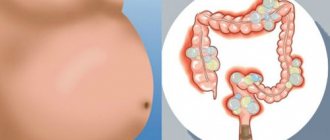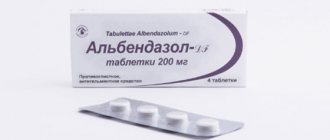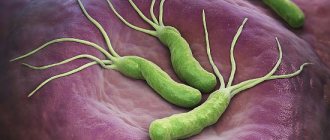People usually know they are sick because they have a fever, sore throat, runny nose, or cough. These symptoms accompany most respiratory diseases. But there are non-standard cases of the disease, for example, bronchitis without cough and fever, which are dangerous because they cannot be immediately identified due to the absence of characteristic symptoms. So, can there be bronchitis without a cough with severe inflammation in the bronchi? To answer this question, you need to know what bronchitis is?
Causes of bronchitis
The bronchi are a paired organ that is a branched tree, the “branches” of which extend into the lungs. Its main function is to transport oxygen from the trachea to the alveoli of the lungs during inhalation and remove carbon dioxide from them during exhalation.
The second function is to purify the air and protect the body from infections and foreign particles (dust, soot, etc.) that enter the respiratory tract along with the air. This is facilitated by the structure of the epithelium, which covers the inner walls of the bronchial tree. This epithelium is called ciliated, since its structure includes cilia that move synchronously in one direction. The cilia constantly vibrate, pushing foreign agents out along with the flow of mucus, which is normally present in the bronchial tubes. In addition to its transport function, mucus also has antimicrobial and antiviral effects. The content of immunoglobulin A, which destroys bacteria and viruses, is ten times higher in mucus than in blood! How well the mucus will perform its protective properties also depends on its rheological properties (fluidity).
After air passes through the trachea and bronchi, it enters the alveoli of the lungs, which are almost sterile.
But the body’s protective function does not always work. Sometimes foreign agents are stronger and penetrate the bronchial mucosa, destroying its cells and causing a response in it - an inflammatory process called bronchitis.
Bronchial tissues swell, its walls thicken, and accordingly, the diameter of the bronchial tube decreases. The body tries to push out the infection by increasing the secretion of mucus and by engaging a protective mechanism such as coughing. But with inflammation, the mucus becomes more viscous, making it difficult to clear.
A decrease in the diameter of the bronchi and the accumulation of viscous mucus in them causes a decrease in their patency, which means difficulty breathing in a person - this is called obstruction.
In the vast majority of cases, the causative agents of the disease are viruses and bacteria - various strains of influenza, parainfluenza, adeno- and rhino-viruses, staphylococci, streptococci, and other pathogens.
It is also possible that the disease may occur due to an allergic reaction of the body. Or due to toxic substances entering the respiratory tract that destroy the bronchial mucosa.
Bronchitis in adults more often develops due to smoking, alcoholism, working in hazardous industries, chronic diseases, and in old age.
Types of bronchitis
According to the form of the course, bronchitis is divided into two types:
- Acute (OB). Inflammation of the bronchial mucosa with an acute course. Occurs once or with long time intervals. Does not lead to further violations of the structure and functions of the organ.
- Chronic (CB). It can develop as a complication after acute or as a result of prolonged exposure to adverse factors - smoking, recurrent infections, inhalation of dust and chemicals. The disease is recurrent in nature and during periods of exacerbation it is less acute. In a chronic course, there is a gradual destruction of the structure of the ciliated epithelium and a decrease in its function. In severe cases, irreversible narrowing of the bronchial lumen and the development of chronic obstructive pulmonary disease (COPD) are possible.
The diagnosis of chronic bronchitis can be made if the patient has periods of coughing with sputum production for at least 3 months during the year. In this case, the observation period must be at least 2 years.
Classification by cause of disease:
- Viral. The most common type.
- Bacterial. It can occur on its own, but more often it joins after a viral one.
- Allergic. Occurs under the influence of an allergen. Characterized by a protracted course, the development of obstruction and chronicity.
- Fungal. Occurs rarely.
- Caused by an atypical infection - chlamydia, mycoplasma.
- Chemical. It rarely causes OB, but plays a significant role in the development of CB.
- Mixed type. Combines several factors in the development of the disease.
Bronchitis is also divided into obstructive - with impaired bronchial patency, and non-obstructive - with preserved bronchial patency.
Physiotherapeutic procedures
If you do not know how to identify acute bronchitis or any other form of the disease, then you should definitely contact a medical facility. Only an experienced specialist can identify the exact cause of the disease and prescribe appropriate treatment. Physiotherapeutic procedures may be prescribed in combination with basic therapy.
Physiotherapy is very effective for this disease. Among such procedures are inhalations, UHF, quartz treatment, ozokerite.
Warming the sternum is prescribed only as an additional treatment procedure, when the exacerbation of the chronic form of bronchitis is relieved or the first stage of therapy for the acute form is carried out.
Massage is done if the patient has difficulty clearing phlegm. This procedure will ensure the opening of the bronchi, as well as the acceleration of the outflow of purulent sputum.
Breathing exercises will help restore breathing and also relieve the patient of shortness of breath.
Inhalations cannot be called only physiotherapeutic procedures, since for the most part such activities represent full-fledged therapy.
Symptoms of bronchitis
The symptoms of the disease and its course may differ depending on its type. However, a characteristic symptom for all forms of the disease is cough and sputum production.
Signs of bronchitis in acute infectious course
Acute uncomplicated disease proceeds stereotypically. As a rule, it begins with inflammation of the upper respiratory tract - nasopharynx, tonsils. Therefore, acute bronchitis of an infectious nature is usually accompanied by a runny nose and sore throat. Then the inflammatory process descends lower, affecting the bronchi.
Cough
Bronchial manifestations begin with a dry cough, which over time turns into a wet (productive) cough - the patient begins to cough up sputum.
In cases of severe disease, a dry cough can be paroxysmal, hacking, and cause pain behind the sternum and between the ribs.
Greenish and yellowish color of sputum indicates a bacterial infection. White or transparent mucus indicates its absence.
Intoxication
Symptoms of general intoxication are typical for OB - weakness, malaise, chills.
Temperature
Body temperature rises. It may be low-grade, or it may rise above 38.5C. A high temperature lasts up to four days; a longer period may indicate the development of pneumonia.
OB lasts on average 10-14 days, but the cough may, after recovery, last up to several weeks, since the healing process of bronchial tissue is quite long.
Chronical bronchitis
The disease has periods of remission and exacerbations. During the period of remission, the patient may not be bothered by anything, but there may be mucous discharge. When an exacerbation occurs, the sputum becomes viscous and acquires a greenish and yellowish color.
The second most common symptom of chronic disease is shortness of breath.
The temperature during an exacerbation may be absent or may be low-grade in nature.
General symptoms - weakness, sweating, fatigue - develop during exacerbation. If such symptoms appear and are in remission, this most likely indicates the development of respiratory failure (COPD).
When COPD occurs, patients have a bluish discoloration of the skin, a puffy face, and thickened terminal phalanges of the fingers. Even slight exertion causes them to feel short of breath.
Allergic bronchitis
The disease develops upon contact with an allergen - household dust, animal hair, plant pollen, perfume, food products. Characterized by a dry cough with wheezing, shortness of breath. Obstructive manifestations are also characteristic, but they are reversible. There is no elevated body temperature. The sputum is mucous in nature without a purulent component.
General malaise and weakness are also possible.
Other allergic manifestations are also associated with bronchopulmonary symptoms - rhinitis, skin rashes, conjunctivitis.
With a pronounced allergic mood of the body, the allergic OB becomes chronic, and the asthmatic component can be connected to it.
Consequences
Bronchitis is a disease that is often accompanied by complications. The most common are:
- bronchial pneumonia;
- transition to a chronic form;
- obstruction of the bronchial tissues. This consequence is often fatal;
- bronchial type asthma;
- emphysema of lung structures;
- cardiopulmonary failure;
- pulmonary artery hypertension;
- pathological dilatation of the bronchi.
If blood appears in the sputum, it is necessary to undergo testing for tuberculosis and cancer.
At the first manifestations of the disease, you should consult a doctor. Only he will be able to determine the type of pathology and select the correct treatment.
There are a number of recommendations that help speed up recovery:
- drinking plenty of fluids. This helps thin mucus and improves its removal. It is better to choose warm drinks that do not contain caffeine;
- keeping quiet, bed rest and constant rest. In order to cope with the disease, the body needs additional strength;
- avoiding eating spicy or very salty foods. Bronchitis can occur simultaneously with inflammation of the oral cavity, so it is necessary to avoid food irritants;
- applying camphor oil to the sternum area. This manipulation helps improve sputum discharge;
- a little physical activity helps speed up the removal of mucus, which helps speed up recovery;
- maintaining optimal air humidity in the room in which the patient spends most of his time. To do this, hang a wet cloth or leave containers with water;
- eliminating bad habits or reducing the number of cigarettes smoked;
- With bronchitis, thermoregulation is impaired, which provokes hyperhidrosis. For this reason, you need to dress appropriately for the weather and maintain personal hygiene.
Diagnosis of the disease
Making a diagnosis begins with collecting the patient’s medical history – a description of symptoms, information about chronic and previously suffered diseases.
Then a series of studies are performed.
Physical examination
The doctor listens to the patient's breathing using a phonendoscope.
With a dry cough, hard breathing speaks in favor of the disease; with a wet cough, wheezing on both sides.
When percussing (tapping) the patient, the tone is without features. A change in sound is characteristic of serious complications.
General clinical blood test with a detailed leukocyte formula
In the acute form of the disease, an increase in ESR and leukocytes will be detected. If the number of lymphocytes in the leukocyte formula is increased, most likely bronchitis has a viral etiology. An increase in the number of neutrophils is more likely to indicate the bacterial nature of the inflammation.
If the level of eosinophils exceeds the norm, this indicates a pronounced allergic component of the disease.
In a chronic course, the indicators may not change or change slightly.
X-ray
Sometimes the patient is recommended to have an x-ray of the lungs. In this case, with bronchitis, an increase in the pulmonary pattern is possible.
In the chronic form of the disease, radiography can reveal various complications - emphysema, bronchiectasis.
Bronchoscopy
Prescribed for the diagnosis of chronic bronchitis and complicated acute bronchitis. The method allows you to clarify the nature of inflammation, its intensity, and identify disorders in the bronchial tree, including organic lesions. And also obtain biological material for microbiological and cytological research.
Sputum examination
Prescribed for moderate, severe and complicated OB, as well as CB. Using the study, the nature and severity of the inflammatory process is determined, and the causative agent of the disease and its sensitivity to antibacterial drugs are identified.
Treatment of bronchitis
Therapy of the disease is aimed at eliminating the source of infection, relieving inflammation, stimulating the process of sputum discharge, and facilitating the patient’s breathing.
Antibacterial therapy
In uncomplicated viral or allergic OB, antibiotics are not needed. They are prescribed when the disease is bacterial in nature, when complications occur or their threat is high.
The need for antibiotics is indicated by the failure of symptomatic and pathogenetic therapy for several days, as well as the change in mucous sputum to purulent.
For complicated acute or severe chronic bronchitis, corticosteroids and immunomodulators can be used.
Suppression of disease development mechanisms
This is also called pathogenetic therapy.
The patient is prescribed the following medications:
- Mucolytics. Necessary for thinning mucus and better expectoration.
- Bronchodilators (bronchodilators). To ease breathing during shortness of breath and relieve bronchospasm.
Mucolytics or bronchodilators are used orally, as well as in the form of inhalations. For this purpose, you can use a home nebulizer or a portable inhaler.
Symptomatic therapy
Antipyretic. Shown only at high temperatures.
Antitussives. Coughing is a protective mechanism to expel infection from the respiratory tract. Therefore, drugs that suppress the cough reflex are prescribed only in cases of prolonged attacks that significantly worsen the patient’s quality of life.
If the patient has obstruction, oxygen therapy is added.
Physiotherapy
Electrophoresis with calcium chloride, inhalations, quartz on the chest area, chest massage, breathing exercises.
If the air in the room where the patient is located is dry (this often happens in winter with steam heating), constant humidification is indicated. The fact is that dry air provokes drying of the mucous membrane of the patient’s respiratory tract, and, as a result, coughing attacks.
The patient also needs to drink plenty of fluids. This is important for two reasons. Firstly, toxins are removed from the body along with fluid, and secondly, a sufficient amount of fluid in the body contributes to better discharge of sputum. For this purpose, warm alkaline mineral water, herbal decoctions from linden, coltsfoot, teas with raspberries and honey are recommended (if there are no allergies).
For chronic bronchitis during the period of remission, sanatorium-resort treatment is indicated. In moderate to severe cases of the disease, patients constantly take maintenance medications aimed at improving bronchial conduction. Such people must do breathing exercises and stop smoking.
Complications of bronchitis
The following factors can lead to complications:
- late started or interrupted treatment;
- non-compliance with doctor's recommendations;
- early or old age;
- concomitant chronic diseases, especially of the respiratory system, immunodeficiencies;
- bad habits.
Pneumonia is a common complication of acute bronchitis. It develops if the inflammatory process from the bronchi moves to the lungs.
The infection can spread beyond the respiratory system, causing inflammation of the membranes of the heart (myocarditis, pericarditis, endocarditis), blood vessels (vasculitis) or kidneys (glomerulonephritis).
Chronic bronchitis can occur as a complication of acute bronchitis. As was said, long-term and severe chronic disease leads to irreversible changes in the bronchopulmonary system. As a result, COPD, bronchiectasis, emphysema, and hemoptysis develop.
Preventive measures
Correct and timely implementation of preventive measures allows in most cases to prevent the occurrence, development or progression of the disease.
Prevention of bronchitis without fever should include:
Quitting smoking is a step you need to take for your own health.
- getting rid of bad habits that negatively affect the respiratory system (smoking) and weaken the immune system (alcohol, drugs, passive lifestyle);
- hardening is a method that helps strengthen the body’s immune forces;
- complete nutrition enriched with vitamins and microelements;
- maintaining an optimal microclimate in the room (regular ventilation and wet cleaning) to reduce microbial contamination of the air.
It should also be taken into account that people who often suffer from inflammatory diseases of the bronchopulmonary system should avoid working in dusty and gassy conditions.
With the development of bronchitis, which is not accompanied by a pronounced temperature reaction, consultation with a qualified doctor is required, as this may be a sign of suppression of the immune system or chronicity of the inflammatory process. For people who are at risk for diseases of the respiratory system, it is necessary to develop preventive measures to help avoid the development of pathology and its complications.










